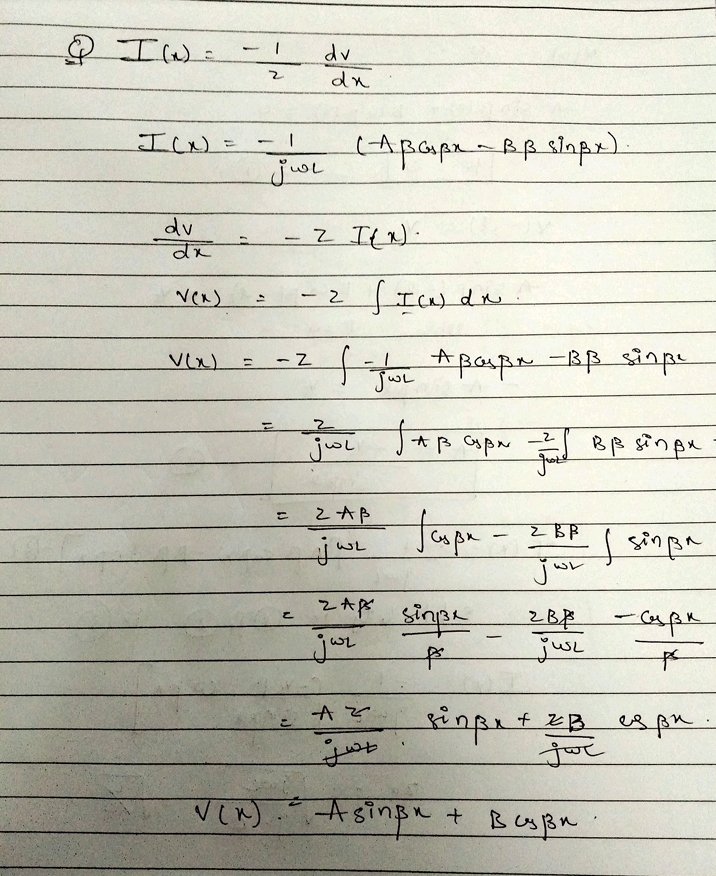ex I (x) ++; Vs = r ✓ dv z dx x= -l i C = I(x) = = (A Cos³x - 13 Simßx) Z. I. I WL депресира - вряпраз WVLC ß. "SVIC (Acos (α - B simßx) √C JLV لكم a = x=0 P با 豐 x ENG INTL
ex I (x) ++; Vs = r ✓ dv z dx x= -l i C = I(x) = = (A Cos³x - 13 Simßx) Z. I. I WL депресира - вряпраз WVLC ß. "SVIC (Acos (α - B simßx) √C JLV لكم a = x=0 P با 豐 x ENG INTL
Introductory Circuit Analysis (13th Edition)
13th Edition
ISBN:9780133923605
Author:Robert L. Boylestad
Publisher:Robert L. Boylestad
Chapter1: Introduction
Section: Chapter Questions
Problem 1P: Visit your local library (at school or home) and describe the extent to which it provides literature...
Related questions
Question
![**Transcription for Educational Website**
### Mathematical Expressions
1. The mathematical expression for current, \( I(x) \), is given by:
\[
I(x) = -\frac{1}{Z} \frac{dV}{dx} = -\frac{1}{j \omega L} \left[ A \beta \cos \beta x - B \beta \sin \beta x \right]
\]
2. Parameters defined:
- \(\beta = \omega \sqrt{LC}\)
3. Derived expression:
\[
I(x) = \frac{j}{Z_0} \left( A \cos \beta x - B \sin \beta x \right)
\]
### Diagram Explanation
- The diagram at the bottom illustrates an electrical transmission line.
- The left side is labeled \( \text{ex} \) indicating an example or exercise.
- An input voltage \( V_s \) is applied at \( x = -l \).
- The line extends to the right where \( x = 0 \).
- The line is depicted as a two-wire transmission line, suggesting analysis over its length.
### Symbols and Variables
- \( j \): Imaginary unit (used in electrical engineering for complex numbers).
- \( Z \): Impedance.
- \( V \): Voltage.
- \( L \): Inductance per unit length.
- \( C \): Capacitance per unit length.
- \( \omega \): Angular frequency.
- \( A, B \): Constants related to boundary conditions.
This content helps explain the derivation and behavior of current in a transmission line, showing how it depends on various electrical properties and conditions.](/v2/_next/image?url=https%3A%2F%2Fcontent.bartleby.com%2Fqna-images%2Fquestion%2F3af11e6a-2a61-4302-a4ee-f3c4efdfe331%2F36566a23-fa32-4ae0-a261-92b716a3b531%2Fthm3dtm_processed.jpeg&w=3840&q=75)
Transcribed Image Text:**Transcription for Educational Website**
### Mathematical Expressions
1. The mathematical expression for current, \( I(x) \), is given by:
\[
I(x) = -\frac{1}{Z} \frac{dV}{dx} = -\frac{1}{j \omega L} \left[ A \beta \cos \beta x - B \beta \sin \beta x \right]
\]
2. Parameters defined:
- \(\beta = \omega \sqrt{LC}\)
3. Derived expression:
\[
I(x) = \frac{j}{Z_0} \left( A \cos \beta x - B \sin \beta x \right)
\]
### Diagram Explanation
- The diagram at the bottom illustrates an electrical transmission line.
- The left side is labeled \( \text{ex} \) indicating an example or exercise.
- An input voltage \( V_s \) is applied at \( x = -l \).
- The line extends to the right where \( x = 0 \).
- The line is depicted as a two-wire transmission line, suggesting analysis over its length.
### Symbols and Variables
- \( j \): Imaginary unit (used in electrical engineering for complex numbers).
- \( Z \): Impedance.
- \( V \): Voltage.
- \( L \): Inductance per unit length.
- \( C \): Capacitance per unit length.
- \( \omega \): Angular frequency.
- \( A, B \): Constants related to boundary conditions.
This content helps explain the derivation and behavior of current in a transmission line, showing how it depends on various electrical properties and conditions.

Transcribed Image Text:The handwritten notes on the page appear to be related to electrical engineering or physics, specifically dealing with wave functions or transmission lines. The transcription of the notes is as follows:
---
If
\( V(0) = 0 \implies B = 0 \)
\( V(x) = A \sin \beta x \)
\( V(-L) = V_s = -A \sin \beta L \implies A = \frac{-V_s}{\sin \beta L} \)
Prove
\( I(x) = \frac{-j V_s \cos \beta x}{Z_0 \sin \beta L} \)
---
There are no graphs or diagrams to describe. The text involves mathematical expressions using trigonometric functions, which are likely related to the analysis of voltage and current in transmission systems or signals characterized by sine waves.
Expert Solution
Step 1

Step by step
Solved in 3 steps with 3 images

Knowledge Booster
Learn more about
Need a deep-dive on the concept behind this application? Look no further. Learn more about this topic, electrical-engineering and related others by exploring similar questions and additional content below.Recommended textbooks for you

Introductory Circuit Analysis (13th Edition)
Electrical Engineering
ISBN:
9780133923605
Author:
Robert L. Boylestad
Publisher:
PEARSON

Delmar's Standard Textbook Of Electricity
Electrical Engineering
ISBN:
9781337900348
Author:
Stephen L. Herman
Publisher:
Cengage Learning

Programmable Logic Controllers
Electrical Engineering
ISBN:
9780073373843
Author:
Frank D. Petruzella
Publisher:
McGraw-Hill Education

Introductory Circuit Analysis (13th Edition)
Electrical Engineering
ISBN:
9780133923605
Author:
Robert L. Boylestad
Publisher:
PEARSON

Delmar's Standard Textbook Of Electricity
Electrical Engineering
ISBN:
9781337900348
Author:
Stephen L. Herman
Publisher:
Cengage Learning

Programmable Logic Controllers
Electrical Engineering
ISBN:
9780073373843
Author:
Frank D. Petruzella
Publisher:
McGraw-Hill Education

Fundamentals of Electric Circuits
Electrical Engineering
ISBN:
9780078028229
Author:
Charles K Alexander, Matthew Sadiku
Publisher:
McGraw-Hill Education

Electric Circuits. (11th Edition)
Electrical Engineering
ISBN:
9780134746968
Author:
James W. Nilsson, Susan Riedel
Publisher:
PEARSON

Engineering Electromagnetics
Electrical Engineering
ISBN:
9780078028151
Author:
Hayt, William H. (william Hart), Jr, BUCK, John A.
Publisher:
Mcgraw-hill Education,